The People Were Great in Edinburgh!
September 23, 1999
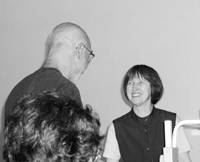
Mathematical biologist Leah Keshet of the University of British Columbia, one of the two women who gave invited talks at the meeting (the other was Margaret Wright); both talks, according to the author, were "stellar."
Bob O'Malley
I very much looked forward to going to Edinburgh for my fourth ICIAM, since I had been heavily involved in the organization of the second congress (in Washington, DC, 1991), and especially since I had long ago spent an enjoyable year visiting the Bateman Manuscript Project's Arthur Erd�lyi in Edinburgh and continue to enjoy the unique city. Of course, some significant people would be missing from this roster of ICIAM attendees, including Julian Cole, who had recently passed away, and David Crighton, who was ailing. I'd get only a glance at or a too-brief word with some old friends, and, indeed, I must apologize to Joe Jerome, Wolfgang Wendland, and many others (some perhaps unrecognized!).
My flights toward Edinburgh were long and dreary, partly because I was reading Ron Rosenbaum's Explaining Hitler. I'd no sooner gotten to baggage claim, however, when I encountered the upbeat Margaret Wright of Bell Laboratories, who told me about her charming interaction with Tom Stoppard at MSRI this spring---especially his claim that Arcadia's Thomasina was not patterned after Byron's daughter, Ada Lovelace. This was in response to an essay by Jay Clayton of Vanderbilt University, "Ada in Arcadia: Stoppard and the Nineteenth Century," that I'd circulated the previous week. (It could be that Stoppard routinely gets input from multiple sources, not all acknowledged, as suggested by Helen and Bruce Bayly; they claim that his Shakespeare in Love shares much with the 194l comic novel No Bed for Bacon, by Brahms and Simon, despite the movie's Oscar for best original screenplay and Stoppard's and Miramax's denials of any connection.) Optimizer Margaret and math biologist Leah Keshet of the University of British Columbia were to be the only female plenary speakers in Edinburgh, since the more senior Olga Oleinik of Moscow State University had to cancel. (Their performances were, incidentally, both stellar.)
After settling into a favorite B&B, featuring a view of Arthur's Seat, I wandered toward registration at the University of Edinburgh's Chaplaincy Centre, off George Square. Along the way, I passed the separate Catholic Chaplaincy we used to attend, once the home of Sir Walter Scott. A Greyfriar stood on the steps in the mist, saying goodbye to congregants leaving Mass. One could hear the mingled chatter of homeless and affluent folks below, enjoying the traditional hospitality. (There was a unique (post-Oxford Movement) Catholic presence in Edinburgh mathematics, due to Sir E.T. Whittaker, maths professor from 1912 to 1946 (and co-author, with G.N. Watson, of the very influential A Course of Modern Analysis), and the recently deceased geometer W.L. Edge, author of Ruled Surfaces.)
Since registration didn't commence 'til two, I settled into the Bookshop Cafe, with good sandwiches and cakes, Seattle-quality espresso, and a wide selection of Penguin paperbacks and 1950s music, looking out at McEwan Hall, where the opening ceremonies would be held in the morning. (Usher Hall, home of the Scottish National Orchestra and funded by another brewing family, had recently been modernized and extended to complement the nearby new convention center. Unfortunately, the renovations to the university's ceremonial McEwan Hall were to begin just after ICIAM. We were stuck with awful acoustics, despite a major effort to compensate with expensive audio equipment.) From the cafe, I could see some delegates arriving. Among them were Ivo Babuska of the University of Texas and his wife (up from the earlier Finite Element Circus at Brunel, organized by John Whiteman) and CICIAM chair Reinhard Mennicken of Regensburg and his companion. (Their delay in getting into their room was not as dramatic as at the meeting of the CICIAM prize committee in Paris in April, when Porsche mechanics had to be called to rue Monge to disengage Mennicken's car alarm!)

Sir Michael Atiyah, chair of ICIAM 99 and host of a Congress Dinner attended by the Duke of Edinburgh, a patron of the congress, and about one hundred guests.
Edinburgh and Heriot-Watt mathematicians Jack Carr, Lyn Thomas, Michael Levitin, and Adri Olde Daalhuis joined professional staff from Meeting Makers in Glasgow and lots of young assistants, including Sir Michael Atiyah's son, in making the combined registration/headquarters operation function very efficiently. In particular, much of the preliminary organization was accomplished through efficient electronic communication and the Web. I was continually amazed throughout the week by Jack Carr's wonderful conviction that all would go well with the program since the people involved were 99% super. If you pressed, he'd recognize complications, but he never let them pull his spirits down. One helpful new feature he introduced to ICIAM was a brief Daily News containing program changes and highlights of the previous day. We were very lucky that the able Jack had been drafted to handle so much of the logistics. Regrettably, Lyn Thomas had to be hospitalized due to overwork, though he seemed to have recovered by Saturday, when Olde Daalhuis had already fled to College Park to do hyperasymptotics with Frank Olver.
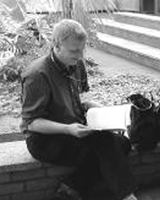
Responsible for much of the good spirit and many of the innovative features that made the meeting work so well was Jack Carr of the University of Edinburgh. Other members of the local organizing committee, from Edinburgh and Heriot-Watt Universities, were Lyn Thomas, Robin Knops, Elmer Rees, Michael Levitin, and Adri Olde Daalhuis.
After wandering around Edinburgh's East End, I was sorry to find that the memorable Valvona and Crolle (like most Italian restaurants worldwide) was not open on Sunday, so (conceding to jet lag) I settled for an early meal at Pizza Express. I noticed Tony Jameson of Stanford and his wife, Charlotte, formerly of the Courant Institute staff, passing up the Bridges, and, generally, an increasing number of folks with distinctive blue ICIAM tote bags (compliments of Springer). Indeed, on the street I had run into Nico Temme of CWI in Amsterdam, just back from Roderick Wong's special functions workshop in Hong Kong; Debbie Lockhart of the National Science Foundation (with her philosopher husband Ted of Michigan Tech, who was making the connection between John Knox and St. Giles); Steve Campbell of North Carolina State (who I had also met on the Sunday before ICIAM 95); and the red-haired Lyudmila Kuzmina of the Kazan Aviation Institute in Russia (who had once briefly visited Boeing).
The Opening Ceremonies were to feature His Royal Highness The Prince Philip, Duke of Edinburgh, and the distinguished jurist Lord Mackay of Clashfern as patrons of ICIAM 99. The Duke, however, was called away to represent the Queen that morning at a memorial service in London for King Hussein. Our program began with an organ recital and speeches by Lord Mackay (who would be further honored by Queen Elizabeth later in the week); Sir Michael Atiyah, chairman of the ICIAM 99 limited corporation; and Lord Sainsbury, the UK Minister of Science. Lord Mackay, who had obtained a PhD in classical analysis before turning to the law, was the organizer of a program on mathematics and the law, held at the Royal Society of Edinburgh on Wednesday (see sidebar). The minister's speech, curiously, emphasized the disproportionate British achievements in science. After some Celtic brass music, Reinhard Mennicken presented the ICIAM prizes.
One had to be proud of and pleased with the superb selections, the first time these four awards were given. Jacques-Louis Lions, the founder of an illustrious French school of applied and computational mathematics, was given the Lagrange Prize for lifetime achievement. His international leadership had been basic to the founding of CICIAM (and especially to the first ICIAM, held in 1987 at the Cit� des Sciences et de l'Industrie in Paris), and his participation as a scientist in government remains a rare model for others to emulate. Stefan M�ller of the Max Planck Institute for Mathematics in the Sciences in Leipzig received the Collatz Prize for outstanding early achievement. His plenary lecture on Thursday demonstrated the breadth and depth of his accomplishments at a young age. Ronald Coifman of Yale University and Helmut Neunzert of the University of Kaiserslautern shared the Pioneer Prize. Their quite different contributions---using wavelets in signal and image processing and developing the technomathematics curriculum and a specialization in industrial mathematics, respectively---establish very high standards for this SIAM-sponsored prize (even though it cost our members twice the anticipated amount!). Grigory I. Barenblatt of the University of California at Berkeley received the Maxwell Prize for originality. I'm personally pleased that this distinguished Russian's contributions to turbulence, combustion, and other fields are based on a special intermediate asymptotics that he devised. As the joyful platform party marched out to be photographed, I noticed the enthusiastic Professor Kuzmina run up to give her congratulations, thereby adding both her hair color and some gender equity to the pictures.
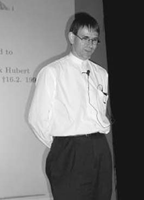
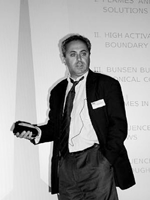
Stefan M�ller (left) of the Max Planck Institute for Mathematics in the Sciences in Leipzig, who received the Collatz Prize (given in recognition of outstanding achievement early in a career) during the opening ceremonies, impressed the author with his invited talk on multiscales and magnetic microstructures. Also receiving high marks was invited speaker Henri Berestycki of the University of Paris VI, who spoke on PDEs in combustion.
The week's program typically involved two plenary sessions in parallel, with the lucky speaker being assigned the George Square Lecture Theatre, and with numerous minisymposia and contributed paper sessions in parallel at various locations about George Square. Everyone faced tough choices in picking sessions to attend. One new feature of this congress was industrially sponsored sessions. The high-level reviews and plenary talks put on by Schlumberger Oilfield Services, on the mathematics of finance and of biology, were a particularly nice addition, even though one organizer, Bob Burridge, has just left Schlumberger for the mechanical engineering department at Boston University and Peter Coveney, the other, recently moved to the University of London. Continuing the industrial involvement, even Jaguar had a booth in the exhibit hall, believing that good engineering design requires clever mathematics (while probably recognizing that few ICIAM delegates would be likely to purchase even their low-end models).
The Edinburgh organizers were particularly fortunate that Sir Michael had recently moved (full of energy) to Edinburgh from Cambridge University, where he had been simultaneously president of the Royal Society, master of Trinity College, and head of the Newton Institute. With Robin Knops, he raised a remarkable amount of sponsorship for ICIAM 99, compared with that available for previous congresses. Such funding was needed, since both the venue and the conference professionals were quite expensive.
The total number of applied mathematicians attending exceeded 1600, about the same as at ICIAM 91. In decreasing numbers, delegates came from the United Kingdom, the United States, Germany, France, Italy, Japan, the Russian Federation, Australia, Canada, Spain, the Netherlands, Austria, Israel, Sweden, Switzerland, Denmark, Finland, Korea, Norway, and forty-five other countries! Certainly, however, the UK contingent could have been larger.

Julian Hunt, chair of the program committee for ICIAM 99.
The weather all week was remarkably pleasant, although one couldn't ever be sure that it wasn't about to change. A number of good places to lunch could be found near the university, on Potter's Row, Nicolson Street, and further afield. I wandered off to the bistro bleu on Victoria Steet one day, and to a Brazilian juice bar with Bob Mattheij and Jan Karel Lenstra of Eindhoven and Georg Bock of Heidelberg on another. (The hostess was pictured in many provocative, but dated, Carnival photos from Rio.) Lenstra had the great idea that the Math Programming Society should join ICIAM, and Mattheij presented me with a big variety of Dutch licorice for my absent wife, Candy. Bock was convincing, as usual, about the benefits of doing math as part of an interdisciplinary team.
Reports of Queen sightings abounded throughout the week. Queen Elizabeth had been in Edinburgh to open the Scottish Parliament on July 1 and stayed in the city through much of ICIAM. I heard that Judy Kapila told her she had come all the way from Troy, New York, for the opportunity to shake Her Majesty's hand.
Sir Michael Atiyah hosted an elegant Congress Dinner for about one hundred guests in the Playfair Library of the Old College, attended by the Duke of Edinburgh and his equerries. Everyone was on his best behavior. Indeed, few women were invited; one of the exceptions was Lady Atiyah, who had studied differential equations at Cambridge with the late Dame Mary Cartwright. This caused some distress for accompanying spouses, although they might have been consoled by the more nouveau menu at the nearby Merchant's Cafe. The charming secretary of the university acted as piper. (I was tempted to ask his expert opinion on what the Seattle microbrew Kiltlifter might refer to, but restrained myself. At the head table, Reinhard Mennicken likewise wondered whether the Duke still spoke German.)
The Duke gave a pleasant speech, mentioning his similar participation in the International Congress of Mathematicians in Edinburgh in 1958 and his experience as founding president of the Institute of Mathematics and its Applications. He specifically mentioned the good food and drink provided by the IMA. This recalls the high style of Norman Clarke and Catherine Richards as IMA directors (and the contrast with the more austere hospitality Ed Block long exhibited as SIAM's managing director).
The evening provided another opportunity to chat with and about old friends. Robin Knops, for example, had some sad news---our common friend Larry Payne of Cornell had recently lost both his priest son and longtime wife, Ruth, to cancer. Always positive, despite his years in the Heriot-Watt administration, Robin also advised me to patronize Cadenhead's Whisky Shop on Canongate, where I found some fantastic Glendronach at 122.6 proof. Tony Jameson, unchanged since we did some control theory together twenty-five years ago, readily suggested a new challenge we might try. Later in the week he gave a plenary talk on computational fluid dynamics, exhibiting the wing design he is more famous for. Among the plenary lectures, I particularly enjoyed those of Jon Chapman (newly appointed professor at Oxford), on superconductivity; Henri Berestycki of Paris VI, on PDEs in combustion; Peter Constantin of the University of Chicago, on turbulence modeling; and Stefan M�ller, on multiscales and magnetic microstructures. The most dynamic plenary talk was, without doubt, that of Jamie Sethian of UC Berkeley, who displayed various ways to track interfacial evolution in real time through proficient use of his laptop.
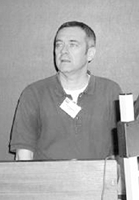
Invited speaker Peter Constantin of the University of Chicago, whose talk was titled "The Navier-Stokes Equations and Fluid Turbulence."
The minisymposia added tremendous breadth and depth to the program (as first envisioned for SIAM meetings by Gene Golub), demonstrating considerable originality on the part of the many organizers. In SIAM President Gil Strang's panel on establishing academic programs in computational science and engineering, Linda Petzold of UC Santa Barbara (who was awarded SIAM's Dahlquist Prize at the congress) was especially forceful when she argued that math must not accept a secondary service role. Gil was provocative when he suggested that the centrality of pure math was past and the death of classical applied math might be before us. I also enjoyed Bob Pego's session, "Models of Domain Coarsening and Coagulation"; Fred Wan and Julius Kaplunov's minisymposia on solid mechanics (which the senior statesman Goldenveizer, unfortunately, could not attend); Edwin Kreuzer and Hans Troger's popular sessions on dimension reduction; and Mark Chaplain's lively sessions on cancer modeling (see sidebar), featuring the conference's most challenging Scottish accent, that of Dundee delegate Alexander Anderson.)
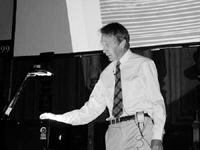
Tony Jameson of Princeton University had the author looking back some twenty-five years to their work in control theory; his invited talk was on the work in computational fluid dynamics for which he is widely known today.
Julian Hunt of Cambridge, the program committee chair, had had the excellent idea of scheduling a wrap-up session. The participants, Bob Mattheij (who has been particularly active in the European Consortium for Mathematics in Industry), Hilary Ockendon (director of the Oxford Centre for Industrial and Applied Mathematics), and Marco Avellaneda of the Courant Institute (who gave a plenary talk on modeling financial risk) discussed the highlights of the conference from their diverse perspectives. All heaped praise on the accomplishments of the organizers, leaving the committee for ICIAM 03, in Sydney, headed by Noel Barton of CSIRO and Ian Sloan of the University of New South Wales, with an even more daunting job. In addition to the ICIAM prizes, SIAM and ETH Z�rich presented the first Peter Henrici Prize to the fine gentleman-scholar Germund Dahlquist of the Royal Institute of Technology in Stockholm. This caused me to recall my numerical analysis courses at Stanford with Seymour Parter. One quarter, we studied the then-new Henrici book Discrete Variable Methods in ODEs, which was very much based on recent work of Dahlquist and Rutishauser. (This had been preceded by a quarter from Varga's Matrix Iterative Analysis and followed by one from Forsythe and Wasow's Finite Difference Methods for PDE's. Sadly, my numerical expertise remains forty years out of date!) I'm sure Germund was delighted that the prize named for him was awarded to Linda Petzold, who does the kind of practical software development he has encouraged his Swedish colleagues to do. Software for fast Fourier transforms earned Matteo Frigo and Steven Johnson of MIT the 1999 Wilkinson Prize. (We used to have so few prizes in applied math. Some, including Gene Golub's wife, Barbara Morris, feel that we now have too many, although Gene generously continues to establish new ones.)
The biggest social event of the week was the reception at the Museum of Scotland, graciously sponsored by Cambridge University Press. (Even Elizabeth Johnston and her assistants from Oxford University Press attended!) A special feature was the appearance of a bewigged and apple-hatted Sir Isaac Newton singing some specially written songs in the style of Gilbert & Sullivan. I was personally delighted that the brochure celebrating the ten-year anniversary of the European Journal of Applied Mathematics listed a contribution by Jacques Laforgue, Michael Ward, and me among its leading papers, although I had previously considered the refereeing the paper faced particularly demanding. Now I'm looking forward to EJAM's publication of Newton's lyrics. Again, this occasion gave us all tremendous opportunities to meet people. It may also have caused some absences on Wednesday morning, however. (Brown University's Chris Jones, in particular, attributed a headache to the red wine.) Afterward, I joined Sam Howison from Oxford and others (including Newton---Graham Wilks of the University of Keele---and his accompanist) for a nearly alcohol-free meal.
David and Tanya Parker hosted a smaller reception at their fashionable Edwardian home, featuring lovely canapes and an international collection of experts on nonlinear waves. There I learned that my old friends Fred and Julia Wan of Irvine were going next to the Ring of Kerry to meet Irish cousins; the Mark Holmes family of Rensselaer had similar plans. I particularly enjoyed meeting Tony Spencer and his artist wife from Nottingham; they assured me that the restoration of George Green's brick wind cornmill (c. 1807), completed in 1985, had been spearheaded by Nottingham mathematicians and physicists. (Civic leaders had demolished Green's birthplace to recognize that of William Booth, founder of the Salvation Army!) Tanya pointed out that the more recent campaign to recognize Green's unschooled achievements was led by a Manx woman, Mary Cannell, whose insightful biography of Green will be republished later this year by SIAM.
The Parkers wisely suggested that I try Sweet Melinda's, a fine new restaurant that initially gathered publicity by letting patrons on Tuesdays pay whatever they thought the meal was worth. (My British solicitor companion naturally warned that the scallops with Pernod might be too flavorful!) I was also happy to return to Hadrian's with Hilary Ockendon, where we had a CICIAM dinner a year earlier. She had haggis! My Scottish dining highlight was at Creeler's (of Skye) on Hunter Square. Their seafood and drink were topped by a sticky toffee pudding with fresh pear, cr�me fraiche, and armagnac sauce! I was thereby only somewhat disappointed to miss seeing John Byatt-Smith of the University of Edinburgh, who is experienced at organizing connoisseurs' pilgrimages to Scotland's finest restaurant, David and Hilary Brown's La Potini�re in nearby Gullane. That's reason enough for a return visit. One of my most interesting mathematical encounters was with Adelaida Vasil'eva of Moscow State University. Our work is similar, and I've tried to promote her school's asymptotic analysis in the West. She showed up at the CUP reception and told me that she'd be speaking in Vladilen Trenogin's session on Friday afternoon. She did so, even though she was scheduled to chair and speak in a minisymposium on singular perturbation theory on Friday morning and in another (conflicting) session on contrast structures on Friday afternoon! Her talk, even her English, was fantastic. She described a beautiful example with shock waves moving across a finite spatial domain, sticking for some time to the boundaries and then reversing themselves in a recurrent pattern. I am really grateful that ICIAM provided a place where we could discuss this important work. Indeed, ICIAM 99 had many participants from the former Soviet Union, coming both from the West and from Russia. Funds had been made available to support them, but not to the extent as at ICIAM 95 in Hamburg.
I missed the follow-up lectures on Maxwellian themes held on Saturday at the Royal Society. Last year, however, I enjoyed my visit to Maxwell's home on India Street in the New Town for the CICIAM board meeting. I was especially interested to learn that the James Clerk Maxwell Foundation (which gave delegates a fine commemorative booklet on Maxwell and provided ICIAM with needed financial support) is chaired by Sidney Ross, a Scottish chemist at Rensselaer, who I remember seeing in the RPI Faculty Club in his corduroy knickers, woolen socks, and bowler hat. I'd heard much about the antiquarian science books he kept in his modest Troy home and understand that this vast and important collection may ultimately find an appropriate home in the Clerk Maxwell birthplace, where they might be available to scholars.
On Saturday, the CICIAM board met, with Gene Golub and me as the SIAM representatives and Gil Strang and Jim Crowley as significant guests with opinions to share. The organization gets more dynamic each year, with the addition of more member societies and the active participation of their representatives. In particular, Chinese SIAM was represented this time by plenary speaker Ya-Xiang Yuan of the Chinese Academy of Sciences (who clarified some of the English phrasing in an important resolution), the Canadian Applied and Industrial Mathematics Society was represented by its next president, Sam Shen of the University of Alberta, and the Indian society was represented by Abul Siddiqi of Aligarh Muslim University in India and King Fahd University in Saudi Arabia. New CICIAM officers are being elected, and plans for the program in Sydney and beyond are under way.
Many left Edinburgh for further meetings (though I was pleased to be returning home). I heard, for example, of a celebration to be held the following week at Strathclyde, where Jim Murray would receive an honorary doctorate, and of another in Bristol for Philip Drazin's retirement. On my 6:40 A.M. flight to Heathrow, I encountered Christian Ringhofer from Arizona State, fresh from a quick trip up to the Highlands. He wondered why ICIAM 99 had such a high registration fee. I gave him a summary of the costs but later considered that it might have been better to follow the example of GAMM and ICIAM 95, charging a lesser amount and still covering the fixed costs through increased attendance. (The conference might then have been even more diverse.) In summary, however, ICIAM 99 was a very convincing demonstration of the vitality and importance of computational and applied mathematics worldwide. (I hope that's the impression Philippe Tondeur, the new director of NSF's math sciences division, also received.) I traveled home wearing a lively ICIAM 03 T-shirt, reading Elizabeth Wilson's biography of Jacqueline du Pr�, happy to have gotten an upgrade.
Robert E. O'Malley, Jr., who chaired the program committee for ICIAM 91 and has attended all four of the congresses, is a professor of mathematics at the University of Washington.

